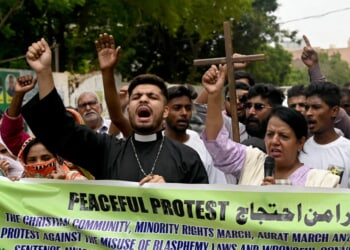President Donald Trump has been working to reach a ceasefire in the Gaza Strip, but questions still remain as to whether or not any peace will last, foreign policy experts told the Daily Caller News Foundation.
Israeli Prime Minister Benjamin Netanyahu met with Trump on Monday and Tuesday to discuss peace prospects in the Middle East, particularly in relation to Hamas, in the wake of U.S. and Israeli strikes on Iran in June. Securing peace in Gaza remains a crucial and challenging element of expanding the Abraham Accords to further normalize Israeli-Arab relations, experts told the Daily Caller News Foundation.
“It’s a very challenging endeavor,” Brent Sadler, senior research fellow at the Allison Center for National Security at the Heritage Foundation, told the DCNF. “I think the only way you get a lasting peace is if Hamas is not part of it because they’ve proven that they are un-reformable.”
The U.S. and Israeli both agreed to a 60-day ceasefire proposal, only leaving Hamas to decide whether or not hostilities will finally cease. Hamas has poured cold water on hopes for a ceasefire, reportedly asking for changes in the terms that Israel finds unacceptable.
Trump threatened Hamas in March that there would be “hell to pay” if the terror group did not come to the table. U.S. Special Envoy Steve Witkoff said Tuesday he was “hopeful” that a deal would be reached for a ceasefire by the end of the week.
The only previous ceasefire between Hamas and Israel lasted approximately three months between January and March 2025, before hostilities resumed due to failed negotiations over the remaining hostages in Hamas captivity.
Hamas has signaled that any peace deal would have to include guarantees that the war would not start again, while Israel has said that can only happen if Hamas agrees to disarmament. Moreover, the jihadist group has placed bounties on Americans helping distribute aid to Palestinian civilians via the Gaza Humanitarian Foundation, according to a State Department cable obtained by The Washington Free Beacon.
Hamas has lost much of its top-level leadership, must deal with a collapsing tunnel network, and faces the prospect of partial abandonment from Iran, its most powerful ally, after Israeli and U.S. strikes crippled Tehran’s own capabilities.
“The events of the last two years have definitely set up a circumstance where potential for breakthroughs like we’ve never seen in the Israeli-Palestinian issue are present,” Sadler told the DCNF. “Iran, their biggest benefactor, an agitator, is on its backfoot.”
Most of the hostages taken into the Gaza Strip from the October 7, 2023, attacks have either been returned during the brief ceasefire from January to March, rescued, or died in captivity. As of June, there are thought to be 50 hostages remaining in Gaza, with 27 considered likely to be deceased.
Even if a ceasefire doesn’t lead to lasting peace, Sadler told the DCNF that the release of some, but not all, of the remaining hostages is a realistic possibility.
“You’re not going to get all the hostages,” Sadler told the DCNF. “I think because Hamas is continuing to use this illegal method as leverage against the Israelis, but I don’t think it’s going to work in the near term.”
Peace in Gaza could be a key piece of Trump’s expansion of the Abraham Accords, particularly for getting Saudi Arabia on board with the diplomatic pact. Gabriel Noronha, president of Polaris National Security, previously told the DCNF that Saudi Arabia’s cooperation in the future may open up a new realm of peace possibilities, potentially spurring other Arab nations to join the pact to counter Iran’s influence.
“If Saudi can get to ‘yes,’ almost all the other nations have indicated they’ll be shortly behind,” Noronha told the DCNF. “Saudi is really difficult, and from what I’ve heard, there’s no prospect of Saudi probably in this year. The Gaza situation really needs to get resolved before Saudi peace can move forward.”
Netanyahu launched “Operation Gideon’s Chariots” on May 17, aiming to achieve a total occupation of the Gaza Strip. The Israeli Defense Forces (IDF) made rapid advances into the region, taking over key corridors and forcing Hamas into a difficult situation.
Israel has also armed rival clans in the Gaza Strip to further pressure Hamas. Such clans may provide a future avenue of engagement for Israel to cut out Hamas if the clans are allowed to establish a more organized structure for diplomatic engagements, Sadler told the DCNF.
The State Department did not respond to the Daily Caller News Foundation’s request for comment.
All republished articles must include our logo, our reporter’s byline, and their DCNF affiliation. For any questions about our guidelines or partnering with us, please contact [email protected].
DONATE TO BIZPAC REVIEW
Please help us! If you are fed up with letting radical big tech execs, phony fact-checkers, tyrannical liberals and a lying mainstream media have unprecedented power over your news please consider making a donation to BPR to help us fight them. Now is the time. Truth has never been more critical!
Success! Thank you for donating. Please share BPR content to help combat the lies.
We have no tolerance for comments containing violence, racism, profanity, vulgarity, doxing, or discourteous behavior. Thank you for partnering with us to maintain fruitful conversation.




![Steak ’n Shake Mocks Cracker Barrel Over Identity-Erasing Rebrand [WATCH]](https://www.right2024.com/wp-content/uploads/2025/08/Steak-n-Shake-Mocks-Cracker-Barrel-Over-Identity-Erasing-Rebrand-WATCH-350x250.jpg)




![Human Trafficking Expert Details Horrific Biden Admin Endangerment of Migrant Kids [WATCH]](https://www.right2024.com/wp-content/uploads/2025/07/Human-Trafficking-Expert-Details-Horrific-Biden-Admin-Endangerment-of-Migrant-350x250.jpg)





